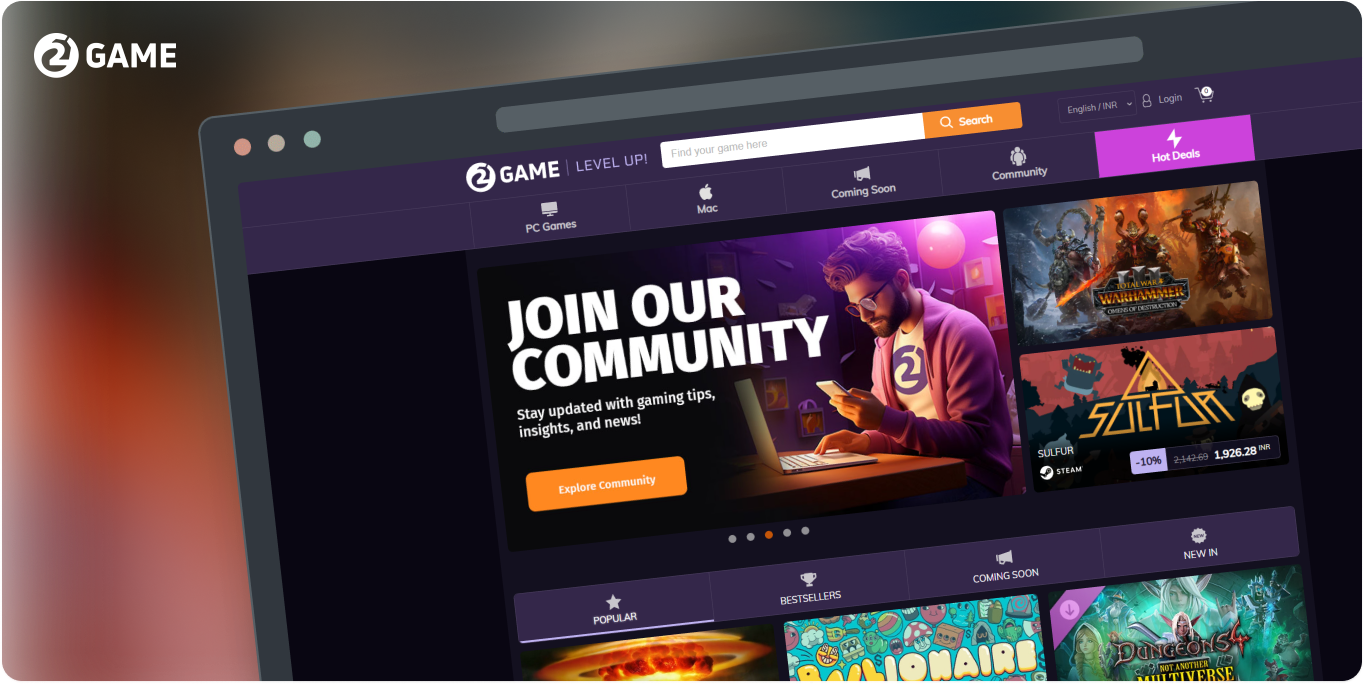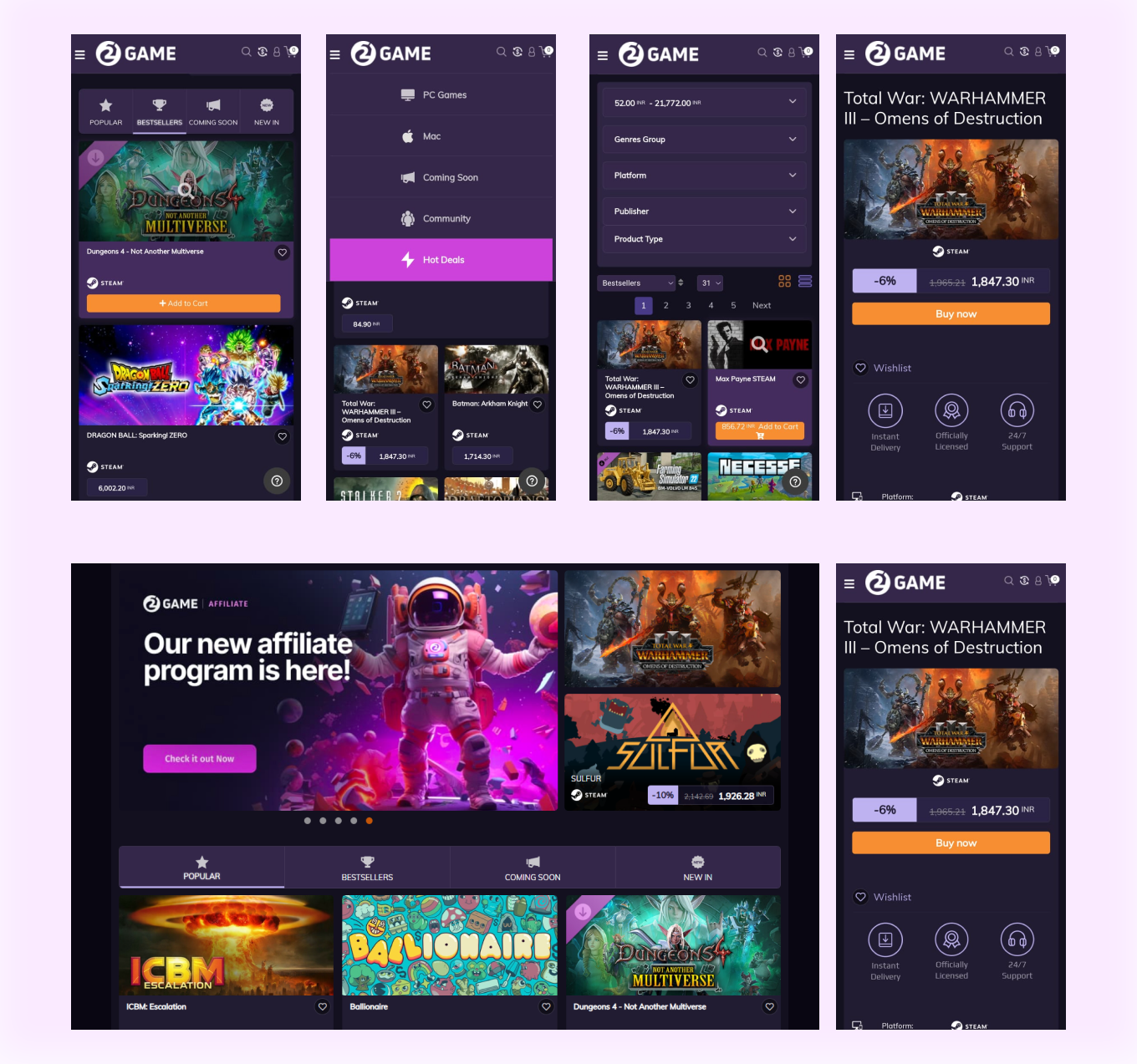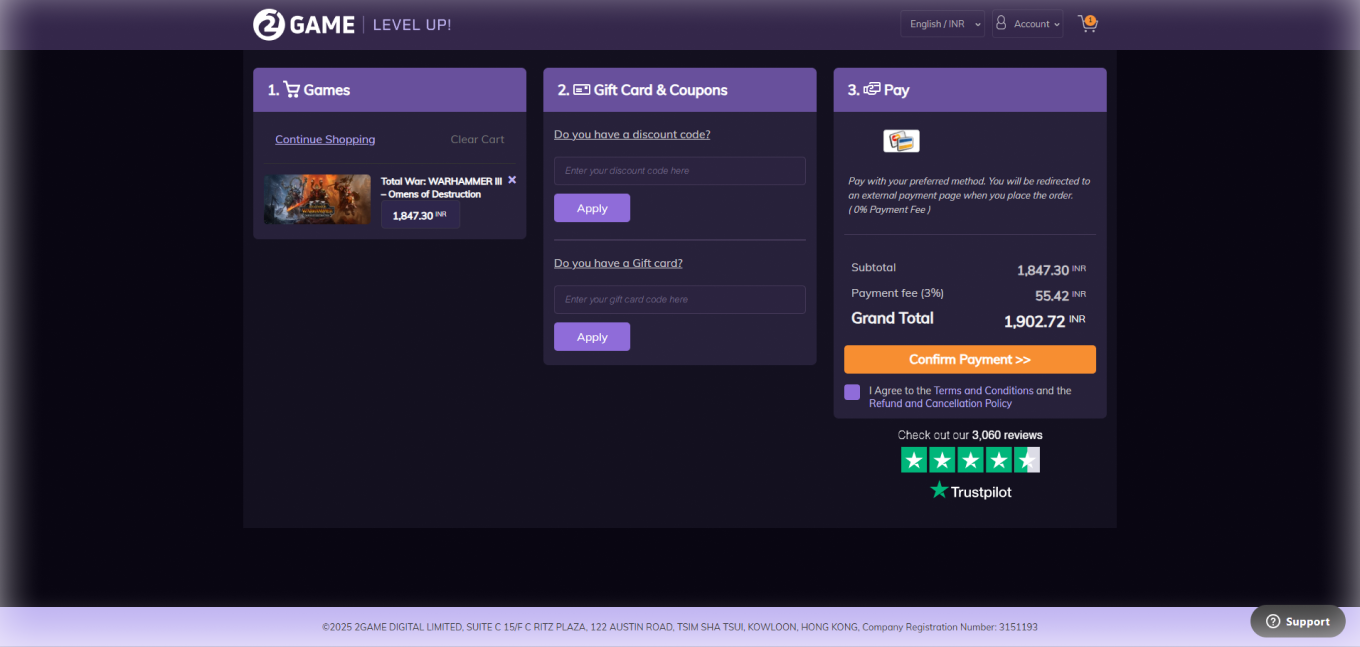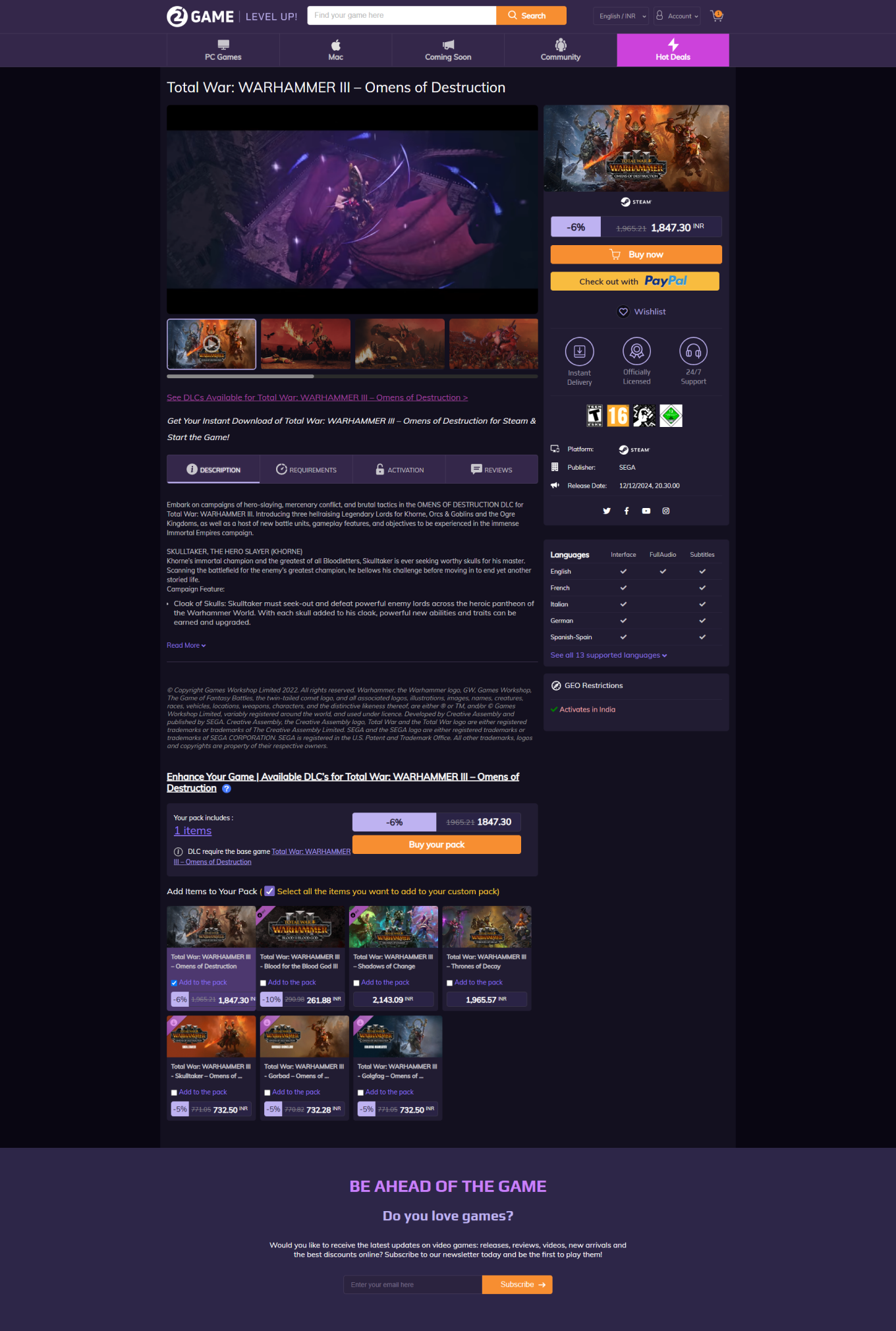
Faced by 2game
The migration of “2Game Digital” from Magento 1.9 to Magento 2 was a comprehensive and challenging project that required careful planning, technical expertise, and rigorous execution to ensure success. One of the primary challenges was preserving the integrity of the website’s existing data, functionalities, and customizations. These elements were integral to maintaining a seamless user experience and supporting the unique operational requirements of the business. The migration process also brought unexpected complexities, including bugs that surfaced both during and after the transition. These issues had to be addressed promptly to prevent disruptions and ensure the website’s reliability.
Additionally, adapting the new store structure to support country-specific stores for customers added another layer of complexity, as it required precise configuration and testing to guarantee accurate and efficient functionality.
Memory leaks and caching issues posed further hurdles, impacting the website’s performance and necessitating robust optimization strategies. Beyond these technical challenges, speed optimization became a critical focus to improve page load times, enhance scalability, and ensure the new platform could handle increased traffic and deliver a superior user experience.
Another critical challenge was streamlining the checkout process to minimize cart abandonment while integrating with third-party tools like ShipStation. Creating a one-step checkout page that combined clarity, speed, and security involved overcoming technical hurdles, such as consolidating multiple user actions into a single interface without compromising on data accuracy or user experience. Furthermore, integrating FullStory analytics and leveraging its insights required a structured approach to interpret customer behavior effectively and implement improvements. Balancing data collection and usability enhancements while maintaining site performance, particularly for mobile users, was a complex undertaking that required meticulous planning and execution.

We successfully completed the migration from Magento 1 to Magento 2 for the EU and HK websites, ensuring a seamless transition to a modern and robust platform.
We meticulously preserved the integrity of the websites’ existing data, functionalities, and customizations, guaranteeing a smooth user experience and uninterrupted business operations.
Our team placed a strong emphasis on enhancing security, stability, and performance by leveraging the advanced architecture of Magento 2.
The data migration process was carefully executed, transferring critical records such as product catalogs, customer data, and order histories for both regions with precision.
To ensure a smooth migration process, we conducted extensive planning, testing, and pre-migration validations, addressing potential challenges proactively.
ost-migration, we promptly resolved bugs and optimized the new system, ensuring reliable functionality and improved performance.
By implementing Magento 2’s enhanced security features, we bolstered protection against vulnerabilities, while speed optimization ensured faster load times and better scalability.
Our expertise enabled us to retain the unique characteristics of the EU and HK websites while unlocking the full potential of the Magento 2 platform.
This project reflects our commitment to delivering seamless migrations that ensure business continuity and position our clients for future growth.
Our team successfully integrated Google Analytics (GA) and Google Tag Manager (GTM) using GraphQL, enabling seamless tracking of critical website metrics.
This integration allows for the efficient collection of data on pageviews, bounce rates, conversion rates, and other essential KPIs, providing a comprehensive view of website performance.
By leveraging GraphQL, we ensured a streamlined process for transmitting data between the Magento 2 platform and GA/GTM, enhancing the accuracy and efficiency of metric tracking.
The insights gained from this integration empower businesses to analyze user behavior, optimize website performance, and make data-driven decisions to improve customer experiences.
This robust setup not only tracks real-time website activity but also ensures scalability and flexibility for future tracking requirements, making it an invaluable tool for monitoring and optimizing the digital journey.
As part of our enhancements, we implemented category-specific product card components to meet unique client design requirements. For instance, we developed custom product card components for the Xbox and Top-Up Card categories, ensuring they aligned perfectly with the client’s desired aesthetic and functional needs.
Additionally, we improved layered navigation on category pages, tailoring it to provide a more user friendly and efficient filtering experience. This customization allowed customers to easily find products based on their preferences.
We also introduced different category templates that dynamically adjust based on attribute values, providing a personalized and optimized layout for each category.
These improvements not only enhanced the visual appeal of the category pages but also ensured a seamless and intuitive shopping experience for customers across the platform.
For the Product Detail Page (PDP) customization, we implemented several key features to enhance user engagement and improve the overall shopping experience. First, we integrated YouTube and Steam videos, as well as product images, directly onto the PDP, allowing customers to access rich media content that showcases the product in action. This not only provided valuable information but also helped customers make more informed purchasing decisions.
Additionally, we customized the PDP to display visual elements based on the product release date, ensuring that products were presented in a way that highlighted their relevance and freshness. This dynamic presentation helped attract customer attention to newly launched items.
Lastly, we implemented GraphQL for related products, ensuring that product recommendations were seamlessly integrated into the PDP. This feature enhanced the shopping experience by providing personalized suggestions, driving cross-selling opportunities, and improving overall conversion rates.
As part of our FishPig Blog GraphQL implementation, we successfully connected the WordPress blog to Magento 2, creating a seamless integration that allowed blog content to be managed within WordPress while being displayed on the Magento frontend.
Using GraphQL, we developed a custom API to fetch blog data from WordPress, ensuring smooth retrieval and presentation of blog posts directly on the Magento 2 site. This integration allowed for easy access to blog content without the need for duplicating data.
Additionally, we implemented a robust blog search functionality that enables users to efficiently search for blog posts based on keywords, categories, or tags. This feature enhanced the user experience by making it easier for visitors to find relevant content, improving overall site engagement and interaction.
Through these customizations, we provided a streamlined and scalable solution that combined the power of both platforms while delivering an optimized experience for end users.
For speed optimization, we focused on enhancing the performance of various key pages on the website, using developer tools and industry best practices. On the home page, we conducted extensive speed optimizations by minimizing unnecessary scripts, optimizing image sizes, and leveraging caching strategies. This resulted in faster load times and a smoother user experience. For the PLP (Product Listing Page), we optimized page elements, reduced server requests, and implemented lazy loading for images, allowing the page to load more quickly, especially for product-heavy categories. On the PDP (Product Detail Page), we optimized resource loading, such as deferring non-critical JavaScript and optimizing product image sizes, to enhance page speed without compromising on visual quality or functionality.
Additionally, we tackled code recursion by identifying and removing redundant code that was causing unnecessary server processing and slowdowns. Using developer tools like Google Chrome’s Lighthouse, PageSpeed Insights, and browser performance profiling, we were able to pinpoint performance bottlenecks and implement effective solutions to significantly improve page load times and overall site responsiveness.

To address the complex challenges of migrating from Magento 1 to Magento 2, as well as optimizing performance, our solution focused on a holistic approach. We ensured a seamless transition by preserving the integrity of the existing data, functionalities, and customizations while leveraging Magento 2’s advanced capabilities to improve security, stability, and scalability. Our team implemented a smooth migration process for the EU and HK websites, prioritizing minimal downtime and efficient data transfer. Post-migration, we tackled issues promptly, resolving bugs and optimizing the system for better performance. Additionally, we integrated Google Analytics and Google Tag Manager via GraphQL, enabling detailed tracking of customer activity and providing valuable insights into website performance. On the frontend, we customized product card components for specific categories like Xbox and Top-Up Cards, improving the shopping experience. Our tailored solutions for the Product Detail Page (PDP), including media integration, dynamic product release displays, and related product recommendations, enhanced user engagement. For the blog section, we successfully integrated WordPress with Magento 2, using GraphQL to fetch and display blog content while implementing search functionality. Finally, we focused on speed optimization across key pages such as the home page, PLP, and PDP, removing redundant code and utilizing developer tools to enhance performance. Our comprehensive solution delivered a high-performance, secure, and scalable Magento 2 platform tailored to the client’s specific needs, positioning them for future growth.

+47.35%
Increase in Conversion Rate
+75.87%
Increase in Revenue
+45.92%
Increase in Users
The migration to Magento 2 was successfully completed, with minimal disruption to the client’s operations. The websites for both the EU and HK regions are now more secure, stable, and scalable, allowing for improved performance and user experience. The customizations implemented, such as the category-specific product card components, dynamic PDP features, and the integration of Google Analytics and Google Tag Manager, have enhanced both functionality and customer engagement. Speed optimizations across the home page, PLP, and PDP have significantly reduced page load times, improving site performance and overall user satisfaction. Additionally, the integration of WordPress with Magento 2 via GraphQL allowed for seamless blog content management and enhanced search functionality. Overall, the project has resulted in a more efficient, user-friendly, and scalable platform that will support the client’s growth while improving operational efficiency and providing valuable insights into customer behavior.
“Working with Viha Digital Commerce for our Magento development was a
game-changer. They migrated our platform seamlessly and enhanced its functionality to handle high traffic efficiently. The team’s expertise ensured our store is optimized for gaming enthusiasts worldwide!”
GET IN TOUCH
Highly Qualified Experts Today!
5000+
Projects Completed
85+
Ecommerce Experts
25+
Countries Tie Up
10+
Years of Experience
Get A Quick Quote
Your eCommerce Solution Specialist

